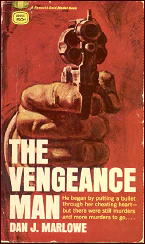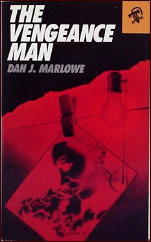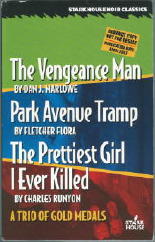Thu 3 Jun 2010
A Review by Noel Nickol: DAN J. MARLOWE – The Vengeance Man.
Posted by Steve under Reviews[5] Comments
DAN J. MARLOWE – The Vengeance Man. Fawcett Gold Medal d1645, paperback original, 1966. Reprint paperbacks: Black Lizard, 1988; Stark House Press, 2007.

Like his masterpiece The Name of the Game is Death, Dan J. Marlowe’s novel The Vengeance Man revolves around a small, insular community filled with intersecting characters and multiple hidden agendas. In fact, the book’s hard-boiled lead, Jim Wilson, makes a point of constantly calling out just how small his backwoods town is, and at certain key moments, turns the claustrophobia of the small town experience to his advantage.
At first Marlowe paints Jim Wilson in broad strokes, portraying him as a typical criminal leading man — low on patience, tough as nails and borderline sociopathic. But as the novel progresses, the novel works to fill in details, giving us a much more personal take on Wilson’s personality. Details emerge on everything from a youth filled with abandonment and abuse to Wilson’s strange passive aggressive relationships with women.
By about hundred pages in, you feel that first-person voice creeping under your skin. You can almost smell Wilson’s rage at a town that he feels betrayed him. And while you’re seeing the world through his revenge-tinted eyes, you can’t help but have a slight fear of whatever his next move might be. The result is something similar to the first-person work of Jim Thompson in novels like Hell of a Woman and The Nothing Man. A frightening insight into the killer mind the none-the-less manages to humanize at the same time. The effect can be chilling.

The book opens with Wilson murdering both his cheating wife and her lover in a flea bag motel. After a carefully orchestrated, if somewhat unrealistic scheme sets him free, he unleashes a campaign of terror on the town — with the end goal of setting himself up as the most feared and powerful man in the community. A title he aims to usurp from his political string-pulling father-in-law, Judge Tom Harrington.
As the story moves forward, we ping-pong between dueling political forces: politicians, bankers, and worst of all, banker’s wives. Of course, we know it’s going to end badly for Wilson. But trying to anticipate when the rug will get pulled, and who will do the pulling is something Marlowe has refined to a pretty fine science.
Throughout the book Marlowe keeps the plot moving at a fast clip with the occasional detour for the sake of color and atmosphere. But there’s nothing even remotely indulgent. As for the quality of the writing, it recalls Gold Medal books at the top of their game: clean, simple and hard boiled.

If there’s a fault to the book it’s the weak characterizations outside of Jim Wilson and his Femme Fatal counterpart. Tom Harrington, for example is built up throughout the first half of the novel as possibly the most dangerous man the south has ever seen. Yet by the time we finally meet him it seems as though Marlowe was unsure how to bring this to life. In the end we’re left unsure exactly what kind of threat he really posed.
The same can be said of other characters throughout the book — from Wilson’s best friend, to his friend-with-benefits. The argument could probably be made that keeping these characters so peripheral helps establish an atmosphere where shocking revelations are truly shocking. But when you don’t have a preconceived notion about a character, surprising the reader with new information doesn’t end up being much of a surprise.
Still, this is a small flaw and it shouldn’t dissuade you from reading one of Dan J. Marlowe’s best books outside of the Earl Drake series.
June 3rd, 2010 at 9:17 pm
Don’t need to convince me about Dan Marlowe. This is one of his best books which is saying a lot.
Marlowe may never have quite reached the heights of some of the Gold Medal writers, but it wasn’t for lack of skill or ability. His very best is very good indeed and even his minor works highly readable.
I also enjoyed his books about hotel dick Johnny Killain written for Avon. With Marlowe you always knew you’d have smart stories and well drawn characters working together.
June 4th, 2010 at 9:10 am
The ending is perfect, and nobody could portray both seething and explosive anger better than Marlowe. I think this one is even better than the outstanding THE NAME OF THE GAME IS DEATH.
Marlowe deserves more acclaim and fame.
June 4th, 2010 at 4:46 pm
Two of Marlowe’s Johnny Killain novels, DOOM SERVICE and SHAKE A CROOKED TOWN can be read for free on-line at Munseys for those who don’t mind reading on the pc and available in most of the major formats replete with nice reproductions of the covers. You’ll find them in their pulp section along with books by Ed Lacy, James Hadley Chase, Charles Willeford, Orrie Hitt, Steve Fisher, and others.
June 4th, 2010 at 5:52 pm
That’s good to know about the Killian books. Before the Internet came along, the books Marlowe did for Avon were always considered scarce and were always priced accordingly.
But for those unwilling to read books on their computers, I see that the original paperbacks are not as hard to find now after all, with many available on ABE in decent condition for less than $10.
I don’t know if Marlowe will make a comeback in terms of fame and acclaim. I’d like to see it, but maybe it’s good enough that the fans he has are very loyal to him.
— Steve
June 4th, 2010 at 7:55 pm
For anyone interested the Killain titles THE FATAL FRAILS, DOORWAY TO DEATH, and KILLER WITH A KEY are now available as is the Berkeley non Killain novel BACKFIRE at Munseys site (all listed under either Dan Marlowe or in their Pulp section which now includes some 938 titles).
There are at least six Ed Lacy titles available including ROOM TO SWING, four by Orrie Hitt, Charles Willeford’s THE WOMAN CHASER, THE WHIP HAND, COCKFIGHTER and others, two by Fredric Brown (including THE SCREAMING MIMI), two by Peter Rabe, THE AVENGER by Matthew Blood (Brett Halliday),all the Bill Lennox novels by W.T. Ballard, three by John MacPhartland including JOHHNY COOL, JOHNNY STACCATO by Frank Boyd, two by Charles Williams, three by Steve Fisher including HOMICIDE JOHNNY, two by Milton Ozaki,all the Doan and Carstairs novels by Norbert Davis, and John D. MacDonald’s A BULLET FOR CINDERELLA among others are available for download.
And for some reason — don’t ask me why, there is a good selection of Miles Burton’s Desmond Merrion novels available in the Pulp section including his masterpiece THE SECRET OF HIGH ELDERSHAM.
Even if you don’t want to read on-line (and I understand why many don’t or can’t) this is a good way to preview these titles before seeking them out in hard copies. In addition there is a good deal of pulp material from several of Johnston McCulley’s Thim Tham Thullivan tales to a good selection of Robert Leslie Bellem’s Dan Turner stories available, and some material both rare and possibly prohibitively expensive to acquire in hard copies.
In addition many of the free readers that you can download are in attractive formats that can be fit to approximate the paperback format — and for those who may have eye problems print can be easily adjusted as can page color to eliminate glare. Mobipocket can handle most formats, and the ones it can’t can be read either with a PDF reader or the excellent FREEREAD (available from an Australian writer along with several other free programs I can recommend).
I’m not trying to sell the format, merely pointing out that it is a valuable resource that can be made use of by readers in many ways. In some cases if only to look a book over before buying it blind from Amazon or Albris or any of the other outlets.
Like anything else it’s a valuable tool for readers with limited resources or who would like to be sure they get the most out of what they have to spend, and in some cases I’ve been able to find and read books that would have been too expensive to purchase or really rare to find.
Of course it doesn’t approach the appeal of a book. No one suggests it does. But if you have a rare paperback that looks as if will fall apart if you take it out of the plastic bag reading it on-line is an awfully attractive option.